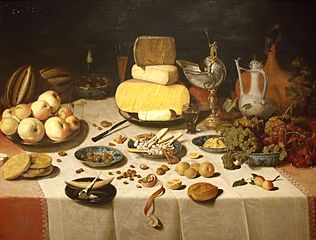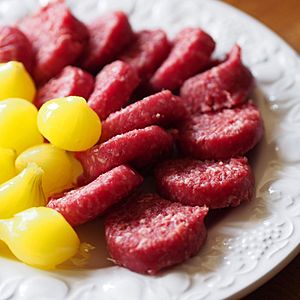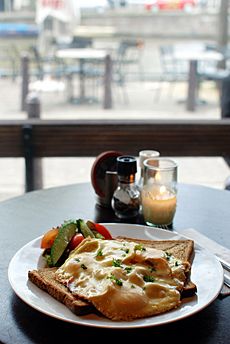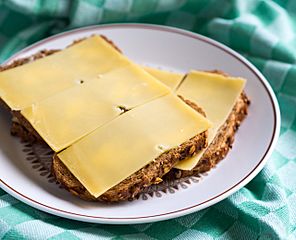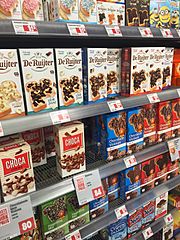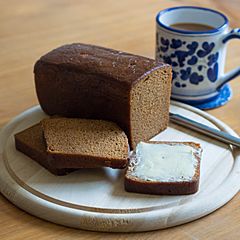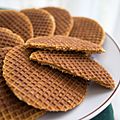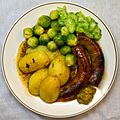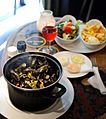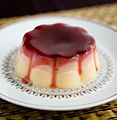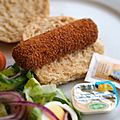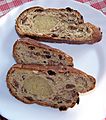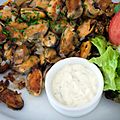Dutch cuisine facts for kids
Dutch cuisine is all about the food traditions and cooking styles from the Netherlands. The country's food has been shaped by its location near the North Sea and big rivers. This area is great for fishing, farming (growing crops and raising animals), and trading by sea. The Dutch also had a big colonial empire and were involved in the spice trade, which brought new flavors.
Traditionally, Dutch food was simple, with lots of vegetables and not much meat. Breakfast and lunch usually involve bread with toppings like cheese. Dinner is often meat and potatoes, with fresh vegetables from the season. People ate a lot of dairy products. Their diet was high in carbs and fats, which was good for the hard-working people who shaped the country's culture. It's best described as "down-to-earth," but many holidays have special foods.
In the 20th century, Dutch food changed. It became more diverse, influenced by foods from its colonies, especially the Dutch East Indies. Today, you can find many different international foods in the big cities.
Contents
History of Dutch Food
Early Days (12th–13th centuries)
We don't have much information about food in the Netherlands during the Middle Ages. People often ate a thick soup called pottage. This soup was made with milk, beer, water, root vegetables, and peas or grains. Sometimes, a piece of meat was added. The ingredients changed depending on the season.
Beer was made in monasteries until the 14th century. It was flavored with a mix of herbs called gruit. Later, hops were used instead, a tradition from Germany. This started a big beer culture, and the Netherlands became a major beer exporter. Beer was a common drink because water wasn't always clean. Milk from the low grasslands was mostly used to make butter and cheese. Dutch butter and cheese became famous very early on and stayed popular for centuries.
Middle Ages (14th–15th centuries)
The sea and rivers provided lots of fish. A fisherman named Willem Beukelszoon from Zeeland invented a way to prepare herring in the 14th century. This invention helped the Dutch create a huge export business for salt herring. They built ships and became a powerful seafaring nation.
Herring is still very important to the Dutch. Every spring, they celebrate Vlaggetjesdag (Flag Day). This tradition goes back to the 14th century when fishermen went out to catch the first herring of the year.
Gardens were first grown by monasteries. Later, castles and country houses also started growing herbs and vegetables. They also had hunting grounds. The famous flower park Keukenhof was once a 15th-century hunting ground and herb garden for a castle kitchen. Fruit orchards, especially for pears and apples, were later used for export. This started a Dutch tradition of growing plants that continues today.
In the 15th century, fancy cooking (called haute cuisine) started to appear, mostly for rich people. The first Dutch cookbook, Een notabel boecxken van cokeryen, was printed around 1510. It had recipes for parties, like sauces, game, jellies, and pies. It also had one of the oldest known recipes for appeltaerten, which is apple pie.
Dutch cooking was closely linked to northern French cuisine because the countries are neighbors. They were also ruled by the same dukes for a time. You can still see this in traditional Dutch restaurants. Southern Dutch food is sometimes called Bourgondisch, meaning "Burgundian," after those old rulers.
Golden Age (16th–17th centuries)
When the Dutch Republic became very rich and powerful in the 17th century (the Dutch Golden Age), fancy dishes became available to wealthy middle-class families. These meals often included many different fruits, cheeses, meats, wine, and nuts. The Dutch Empire allowed spices, sugar, and exotic fruits to be brought into the country.
The Dutch East India Company was the first to bring a lot of coffee to Europe. The Dutch later grew coffee in places like Java. By the late 17th century, drinking tea and coffee became part of daily life. Tea was served with sweets, candy, or cookies. Cheaper spices led to a tradition of spiced cookies called speculaas. Bakers kept their recipes secret.
Dutch kitchens at this time prepared vegetables, meat, poultry, and fish. Meals started with salads and cooked vegetables with dressing. Then came many fish and meat dishes. Exotic ingredients like dates, rice, cinnamon, and saffron were used. Sweet tarts and pastries followed. Meals ended with jellies, cheese, nuts, and sweet pastries, often with spiced wine. Of course, not everyone could afford these luxuries. Most Dutch people still ate simple grain or bean stews with rye bread.
- Dutch Golden Age - historical cuisine
Later Years (18th–19th centuries)
In the late 18th century, the potato became very popular. By 1800, it was a main food. In the early 19th century, rich people could eat what they wanted. But working people ate bread (sometimes rye bread) and potatoes. Sometimes they had pancakes, fish, fruit, and vegetables, but usually little meat. Their diet was simple and often led to poor nutrition.
Potatoes were often eaten at every meal, every day. They were boiled for lunch, then warmed and mashed for dinner. Leftovers were saved for breakfast. They were served with salt, sometimes vinegar, but without gravy or fat. This made for a very plain diet.
During the 19th century, poor people drank mostly water (which wasn't always clean). Sometimes they drank weak coffee or tea. In some areas, hot chocolate was popular. But the most common drinks (besides water) were beer and Jenever (a type of gin).
Modern Times (20th–21st centuries)
The simple, traditional Dutch food we know today actually became popular more recently. In the 20th century, many girls went to "housekeeping schools" (Huishoudschool). There, young women learned to be good housewives. A big part of the lessons was cooking cheap and simple meals, often based on older Dutch dishes. This made Dutch food more similar across the country. These schools also taught about saving money, good table manners, and healthy eating.
Dutch Food by Region

Today, food experts divide Dutch cooking into three main regions.
Northeastern Food
This region includes the provinces of Groningen, Friesland, Drenthe, Overijssel, and northern Gelderland. It's the least populated part of the Netherlands. Large-scale farming started later here (in the 18th century). So, the food is known for many kinds of meats. There were fewer farms, which meant more wild game and livestock. However, coastal areas in Friesland and Groningen also eat a lot of fish.
Different types of dried sausages, like the metworst family, are popular here. They are known for their strong taste. Many towns have their own special sausage. This region also makes smoked sausages, with rookworst (smoked sausage) from Gelderland being the most famous. These sausages are smoked over wood chips and boiled before eating. They are juicy and fatty. Larger sausages are often eaten with stamppot (mashed potatoes with vegetables) or hutspot (a potato and carrot stew). Smaller ones are often eaten as street food.
These provinces also make rye bread and many kinds of pastries and cookies. Unlike southern Dutch food, which is often soft, northeastern rye bread and pastries are usually hard. The pastries are heavily spiced with ginger or candied fruit. Kruidkoek (gingerbread-like cake), Fryske dúmkes (Frisian cookies), and spekdik (small savory pancakes) are typical.
Frisian rye bread is famous for its taste. It's baked for a very long time (up to 20 hours), which gives it a sweet taste and a dark color. Friesland also makes cheese, like Friese Nagelkaas (Friesian Clove cheese), because it has lots of grasslands.
Western Food
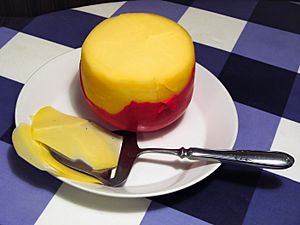
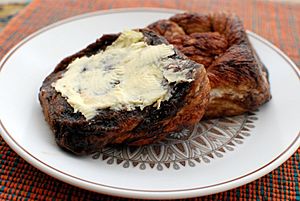
This area includes North Holland, South Holland, Zeeland, Utrecht, and the Betuwe region of Gelderland. Because there's a lot of water and grassland for dairy cows, this region is known for its many dairy products. For centuries, famous cheeses like Gouda, Leyden (with cumin), and Edam (small round cheeses) have come from here. Newer cheese brands like Leerdammer are also from this area. Zeeland and South Holland produce a lot of butter, which has more milkfat than most other European butters. Buttermilk (karnemelk), a leftover from making butter, is also typical.
Seafood like soused herring, mussels (cleaned in Zeeland), eels, oysters, and shrimp are common here. Kibbeling, small pieces of battered white fish, has become a national fast food.
Ossenworst (ox sausage) is a raw beef sausage from Amsterdam. It used to be made from ox meat. The spices in the sausage, like pepper, cloves, and nutmeg, came from the Dutch East Indies. It's often eaten with Amsterdamse uitjes, a type of pickled onion.
Pastries in this area are often doughy and very sweet. The oliebol (a type of doughnut) and Zeeuwse bolus (a sticky pastry) are good examples. Many cookies are also made, often with lots of butter and sugar, like stroopwafel (syrup waffle). Some have fillings, usually almond.
Zaanstreek in North Holland is famous for its chocolate industry. This is because of the "Dutch process" for chocolate developed in 1828. This process helped turn chocolate into a solid form. The popular chocomel, a chocolate-flavored milk, is often drunk when ice skating. Zaanstreek is also known for its mayonnaise (popular with French fries) and whole-grain mustards (popular with bitterballen).
The traditional alcoholic drinks here are beer (strong pale lager) and Jenever, a juniper-flavored spirit that became known as gin in England.
Southern Food
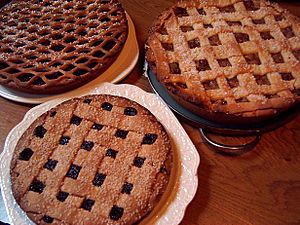
Southern Dutch food comes from the provinces of North Brabant and Limburg, and the Flemish region in Belgium. It's known for its rich pastries, soups, stews, and vegetable dishes. It's often called Burgundian, which means rich and fancy, like the feasts of the old Burgundian court.
This is the only Dutch region that developed fancy cooking. It's the basis for most traditional Dutch restaurants. Main dishes often include premium cuts of meat like Biefstuk (steak) or Varkenshaas (pork tenderloin). These are served with many sauces and potatoes, often double-fried.
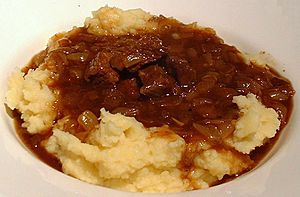
Stews like hachee (a stew of onions, beef, and thick gravy) are full of flavor and take hours to make. Vegetable soups are made from rich stock and usually have small meatballs and many different vegetables. Asparagus and witloof (Belgian endive) are highly valued and traditionally eaten with cheese or ham.
There are many pastries, often with rich fillings of cream, custard, or fruits. Cakes like Vlaai from Limburg and Moorkop and Bossche Bol from Brabant are typical. Savory pastries also exist, like the Brabantian worstenbroodje (a roll with a sausage of ground beef), which is very popular.
Where Dutch Foods Come From
Native Foods
Dutch farming has five main parts: growing crops, growing things in greenhouses, fruit farming, raising animals, and fishing.
- Crops: This includes potatoes, kale, beetroot, green beans, carrots, onions, all common kinds of cabbages, Brussels sprouts, cauliflower, endive, spinach, Belgian endive, asparagus, and lettuce.
- Greenhouses: Used to grow tomatoes, lettuce, cucumbers, and sweet peppers.
- Fruits: Includes apples, pears, cherries, berries, and plums.
- Animals: The Dutch raise cattle for milk, butter, cheese, and meat. They raise chickens for eggs and meat, and pigs for meat. Goats are increasingly raised for cheese.
- Fish: The fishing industry catches cod, herring, European plaice, sole, mackerel, eels, tuna, salmon, trout, oysters, mussels, shrimp, and sardines. The Dutch are famous for their smoked eel and raw herring.
Colonial Influences
Indonesian dishes became popular in the Netherlands after people from the former Dutch colonies moved there, especially after Indonesia became independent in 1945. Some Indonesian dishes became so popular that they are now seen as "national dishes." These include nasi goreng (fried rice), pisang goreng (fried bananas), lumpia goreng (fried spring rolls), bami (fried noodles), satay (grilled meat skewers), and satay sauce (peanut sauce).
One famous Dutch-Indonesian meal is the rijsttafel ("rice table"). This is a big meal with many (sometimes dozens) of small dishes. While popular in the Netherlands, rijsttafel is rare in Indonesia now. Almost every town in the Netherlands has an Indonesian-Chinese restaurant. A popular mix-up dish is friet saté or patatje oorlog, which is French fries with satay sauce, often sold at snack bars.
Surinamese cuisine is also popular, especially in bigger cities. Surinamese places often offer roti (a flatbread), different Surinamese versions of Chinese food, and Surinamese sandwiches.
International Influences
Italian and American style pizzerias are very common. In recent years, Arab and Turkish dishes have also become popular, especially as snacks. In larger towns, you can find small restaurants selling kebabs, shawarma, and falafel almost everywhere. Today, you can find food from all over the world in the Netherlands, especially in bigger cities. This includes Greek, Thai, Japanese, and African foods.
How Meals are Structured
Breakfast and Lunch
Breakfast and lunch in Dutch cooking are quite similar. Both usually involve bread with many different cold cuts, cheeses, and sweet toppings. Sweet toppings include hagelslag (chocolate sprinkles), vlokken (chocolate flakes), muisjes (aniseed sprinkles), and stroop (a thick, dark sugar syrup). Non-sweet spreads include peanut butter and filet americain (a finely ground raw beef spread).
The Dutch are famous for their cheeses. Most Dutch cheeses are semi-hard or hard. Famous ones include Gouda, Edam, and Leyden. A special Dutch way to make cheese is to mix in herbs or spices early in the process. Famous examples are cheeses with cloves or cumin.
Dutch bread is often light and airy, made with yeast. Since the 1970s, Dutch bread has mostly been whole-grain, often with seeds like sunflower or pumpkin seeds for flavor. Rye bread is one of the few dense breads. White bread used to be a luxury. A special Frisian white bread is suikerbrood, which has big lumps of sugar mixed in. Kerststol is a traditional Dutch Christmas bread with dried fruits, raisins, and almond paste. It's eaten sliced with butter.
Ontbijtkoek (gingerbread-like cake) can be eaten instead of a full breakfast or as a snack. It's served as a small slice, usually with butter.
Tea Time
Dutch people often invite friends over for koffietijd (coffee time). This means coffee and cake or a biscuit. It happens between 10:00 and 11:00 am (before lunch), 4:00 pm (between lunch and dinner), or between 7:00 pm and 8:00 pm (after dinner).
The Dutch drink coffee and tea throughout the day, often with one or two biscuits. A popular story says that in the 1940s, the wife of the Dutch Prime Minister served an American diplomat coffee with only one biscuit. This made the diplomat think that money from the Marshall Plan (aid from the US) was being used wisely.
Café au lait is also common. It's called koffie verkeerd (meaning "wrong coffee") and has equal parts black coffee and hot milk. The Dutch drink tea without milk, and it's usually weaker than English or Irish teas. Hot chocolate is very popular in autumn and winter.
Snack Time (Borreltijd)

Between 5:00 pm and 9:00 pm, it's time for an alcoholic drink (borrel), like beer or wine, and a savory snack. This is when the famous bitterballen are served. These are small, deep-fried balls filled with a creamy meat stew, covered in crunchy bread crumbs. Bitterballen are served with mustard.
Borreltijd mostly happens on weekends. Borrelnootje (peanuts in a spiced coating) and kaasstengels (crispy cheese sticks) are other typical borrel snacks.
Dinner
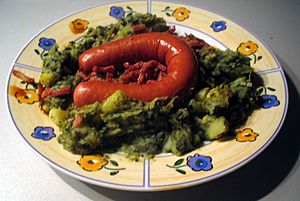
Dinner is traditionally served early, around 6 o'clock in the evening or even earlier. The old-fashioned Dutch dinner is one simple course: potatoes, meat, and vegetables. This is known as "AVG" (aardappelen, vlees, groente). It usually has a lot of vegetables, a small portion of meat with gravy, or a potato and vegetable stew. Stews are often served with pickles, like gherkins or cocktail onions.
These meals were historically for common workers. From the 17th to 19th centuries, workers spent long hours in farms or factories. So, these meals are high in calories and fat to give them energy.
- Stamppot: Boiled potatoes mashed with vegetables, served with meat and/or gravy. There are many types:
* Hutspot: Made with potatoes, carrots, and onions. Served with smoked sausage or slow-cooked meat. * Stamppot andijvie: Raw endive mashed with hot potatoes, served with fried bacon. * Hete bliksem ("hot lightning"): Boiled potatoes and green apples, served with syrup or bacon. * Stamppot zuurkool: Sauerkraut mashed with potatoes. Served with fried bacon or sausage. * Stamppot boerenkool: Curly kale mixed with potatoes. Served with gravy, mustard, and smoked sausage. This is one of the oldest and most popular Dutch dishes.
- Snert: Also called erwtensoep, this is a very thick pea soup. It can be a main dish or a starter and is eaten in winter. It's so thick that people say you should be able to stand a spoon upright in it! It often has pork and smoked sausage pieces. It's usually served with rye bread spread with butter and topped with bacon.
Meat dishes:
- Gehaktballen: Meatballs, usually half pork, half beef.
- Slavink: Minced meat wrapped in bacon.
- Balkenbrij: A type of liver sausage and meatloaf.
Flour dishes:
- Pannekoeken: Large, thin pancakes with bacon, apples, cheese, or raisins.
- Poffertjes: Miniature pancakes.
- Wentelteefjes: Similar to French toast.
Seafood:
- Mosselen (Mussels): Popular and often served with French fries.
- Kibbeling: Chunks of sea fish that are battered and fried.
Dessert
The last course is a sweet dessert. Traditionally, it's yogurt with some sugar or vla, a thin milk pudding. Other desserts include:
- Vla (vanilla custard) often mixed with yogurt.
- Broodpap: A bread porridge made from old bread, milk, butter, and sugar.
- Griesmeelpudding: A sweet pudding made of semolina with red berry sauce.
- Rijstebrij (rice pudding).
Special Occasions

When a baby is born, people serve beschuit met muisjes (Dutch rusk covered with sugared aniseed).
The Dutch festival of Sinterklaas is on December 5th. Saint Nicholas leaves gifts in children's shoes. For this, people drink hot chocolate milk and eat spice cookies like speculaas. Special treats include pepernoten (small cookies made of rye, honey, and anise) and kruidnoten (gingerbread-like biscuits with speculaas spices). Also popular are boterletter (a pastry shaped like a letter), chocolate letters, and marzipan shapes.
Christmas in the Netherlands is a family holiday. Traditionally, there's a family brunch with kerststol (fruited raisin bread, often with almond paste). Christmas dinner is also a family meal, with roast pork, game, or other fancy meat. Another popular Christmas tradition is gourmetten, where people cook their own food on a special grill at the table.

On New Year's Eve, Dutch homes smell of hot oil from deep-fat fryers. They use them to make oliebollen (doughnut-like balls) and appelbeignets (apple fritters). Oliebollen are yeast dough balls, sometimes with fruit or raisins, served with powdered sugar. They are a special treat for New Year's Eve. In the 17th century, Dutch settlers brought their oliebollen to America, where they became known as doughnuts.

On birthdays, all kinds of cakes and cookies are eaten. These include appeltaart, bossche bol, Limburgse vlaai, and stroopwafel. Poffertjes are tiny puffed pancakes served on special occasions. They are served warm with melting butter and powdered sugar. You can find them in special poffertjeskraam restaurants.
Sweets
A famous Dutch sweet is zoute drop and other liquorice sweets. These are small, black, and look like gums. There are four types: soft sweet, soft salt, hard sweet, and hard salty. Liquorice can be bought in shops and pharmacies. It's also thought to help with sore throats and stomach aches. Dutch drop comes in many shapes and forms. When flavored with coconut, they are called Engelse drop (English liquorice). Other types are made with honey or salt.
Another popular Dutch sweet is the stroopwafel ("syrup waffle"). This is a thin waffle cookie sliced in half with a layer of syrup in the middle. Sometimes, crushed hazelnuts are mixed with the syrup, and the dough might have cinnamon.
One Dutch pastry specialty is vlaai. It's a sweet pie made with yeast dough and filled with fruit (like apple, apricot, or plum). Other ingredients might include custard or rhubarb. Rice vlaai and pudding vlaai are also popular. They can be topped with fruits, whipped cream, or chocolate.
Banket is a type of pastry or cookie eaten traditionally on Saint Nicholas Day (December 5th) and Christmas Eve.
Fast Food
The Dutch have their own types of fast food, sold at a snack bar. A Dutch fast food meal often includes French fries (called patat or friet) with sauce and meat. The most common sauce for fries is fritessaus (a low-fat mayonnaise substitute), or ketchup (often a spicy currysaus type), hot peanut sauce, or a pickle relish.
Sometimes, fries are served with a mix of sauces. Speciaal (meaning "special") has mayonnaise, spiced ketchup, and chopped raw onions. oorlog (meaning "war") has fries covered in hot peanut sauce, mayonnaise, and chopped raw onions.
A newer Dutch-Turkish dish from Rotterdam is the kapsalon (meaning "barbershop"). It has fries topped with shawarma, kebab, or döner kebab, then salad, cheese, and sauces like sambal and garlic sauce.
Meat snacks are usually deep-fried. This includes the frikandel (a skinless minced meat sausage) and the kroket (a meat stew roll covered in breadcrumbs). They are often served in bread rolls. A smaller, round version of the croquette is the bitterballen with mustard. These are often served as snacks in bars.
Fish is also sold as fast food at viskraam (fish stalls). The Netherlands is famous for its raw herring. It's often served with chopped raw onions and gherkins. People eat it by holding the herring by its tail and biting into it. Raw herring is also sold in a soft white bun.
Other popular fish snacks are kibbeling (deep-fried chunks of cod) and lekkerbekje (deep-fried cod, similar to British fish and chips). Also popular are gerookte paling (smoked eel) and rollmops.
Images for kids
-
Krentenbollen are eaten with butter or cheese for breakfast, lunch, or as a snack.
-
Stroopwafels (syrup waffles) are a treat consisting of waffles with caramel-like syrup filling.
-
Babi panggang speciaal was, although seemingly Indonesian-Chinese in origin, possibly devised in the Netherlands.
-
Broodje bakkeljauw is a Dutch-Surinamese bun containing dried and salted cod, here with a chili dip made from Madame Jeanette chili peppers.
-
Mussels (Mosselen met friet) are usually served with chips and dipping sauces.
-
Gebakken sliptong: young sole (also known as "slip") fried in butter.
-
Kibbeling are battered deep-fried pieces of fish which are popular as a snack.
-
Poffertjes are made in a special, so-called, poffertjespan.
-
Griesmeelpudding met rode bessensaus is semolina pudding served with red currant sauce.
-
Hutspot with beef.
-
A broodje kroket served for lunch.
-
Bitterballen are small snacks similar to the larger kroketten and are usually served with mustard.
-
Slices of kerststol showing the almond paste in the middle.
-
Eating "Hollandse Nieuwe" (Dutch brined herring) the Dutch way.
-
A saucijzenbroodje is a popular snack in the Netherlands and is the Dutch variant of a sausage roll.
See also
 In Spanish: Gastronomía de los Países Bajos para niños
In Spanish: Gastronomía de los Países Bajos para niños








